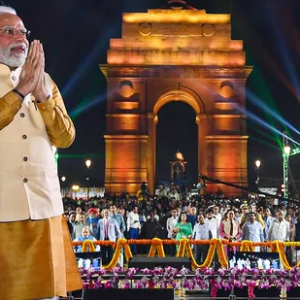~ By Sudarshan Ramabadran
India Today + Information Technology = India Tomorrow, this was envisioned by Prime Minister Narendra Modi in 2013 as Chief Minister Minister of Gujarat while addressing the Annual Google Tent Conference. True to his vision, the Government of India (GoI) has set out on a vital task to prepare India for a knowledge future, i.e., Digital India.
Armed with the vision to transform India into a connected knowledge economy offering world class services at the click of a mouse, the Digital India initiative will have Indian mobile phones, PCs and laptops as its backbone.
Imagine how convenient it would be if services of critical sectors like Health and Education is made accessible to us just through the click of a mouse? The Digital India initiative aspires to do just that by building a digital infrastructure for providing citizens with services like digital identities, mobile phones, and bank accounts. Secondly the initiative aims to service and govern a real-time online financial transaction platform, and finally, the initiative will help digitize all documents and records of the citizens and make them available on a real-time basis.
The Digital India Dream:
- Rural Broadband for All – Target : 2.5 lakh villages
- Universal Mobile Access – Target : 42,300 villages
- WiFi in Universities – Target : 400 Universities
- Public WiFi spots in cities with over 1 million population
Take for example, Rural Broadband for all, this is a critical infrastructure for emerging economies like ours. Experts and verified reports have stated that if there is 10 per cent increase in broadband penetration, this in turn will lead to an increase of the country’s GDP by 1.4 per cent.
Now it is natural for a common man to pose a question, while all this seems fine on paper, what discernible results are going to be witnessed through ‘Digital India’?
To put it simply, the initiative has multiple benefits for our country, prominent among them being Skill Development which will ensure that the right man has the right job.
A brief case in point, the international chip maker, Intel, recently announced that they will work with GoI to empower at least five million citizens with adequate skills to compete in the global economy. Under the programme, Intel has offered digital literacy training to key resource persons in the first 1000 village panchayats under the National Optic Fiber Network (NOFN) which falls under creation of broadband spectrum for Rural India. Let’s take a step back and just imagine how beneficial this would indeed be. First and foremost it will enable access to internet for rural youth who have earlier deprived of the same, next, it offers them an opportunity to understand and learn digital literacy through their local languages, which by itself is a first and finally it will provide them with skill based employment opportunities. So, here is a classic case, of how a tie up between Intel and GoI for the Digital India initiative will have an impact on 5 million people.
The fact that an ordinary citizen continues to run from pillar to post to avail basic citizen centric services today signifies the transformation which Digital India aims to achieve, that is, to provide all basic citizen centric services under one roof for an ordinary citizen to take benefit from. Take for instance, common service centres, which is an interesting example as part of penetration of broadband facilities in villages. Basically, these common service centres will serve as critical pivots around which most goods and services will be delivered. Once connected to broadband, an entire village’s requirements of goods can be placed through these centres and people can use these facilities as one-stop shop for all their e-needs. Through Common Service Centres, the Government wants to ensure that citizens especially in rural areas are not excluded both socially and economically, which by itself is a leap towards eliminating poverty.
Like these there are countless possibilities which will result in empowering citizens digitally with the rapidly modernizing world. Initiatives like this also provide opportunities for youngsters in India to think and come up with innovative ideas and concepts which can help steer the Digital India initiative. Gone are the days when infrastructure development was just thought of building rail lines, ports, roads etc. Now is the time to think and think big, as PM Modi says, “Indians must think of how to move from High ways to Information ways.”
If any Indian citizen has thought of suggestions which could indeed help add value to the Digital India initiative, he/she must not waste any time but log on to www.mygov.in, which means My Government (Meri Sarkar), and give suggestions, feedback, and their analysis towards, empowering India Digitally.
Time is ripe to not just to sit back and read in the media about the initiatives of the Government, but to also put in collective minds to use in order to contribute and become a significant part of the Government. That is the beauty of Participative Democracy!
Sudarshan Ramabadran is a Research Associate with India Foundation. The views expressed are his own.


